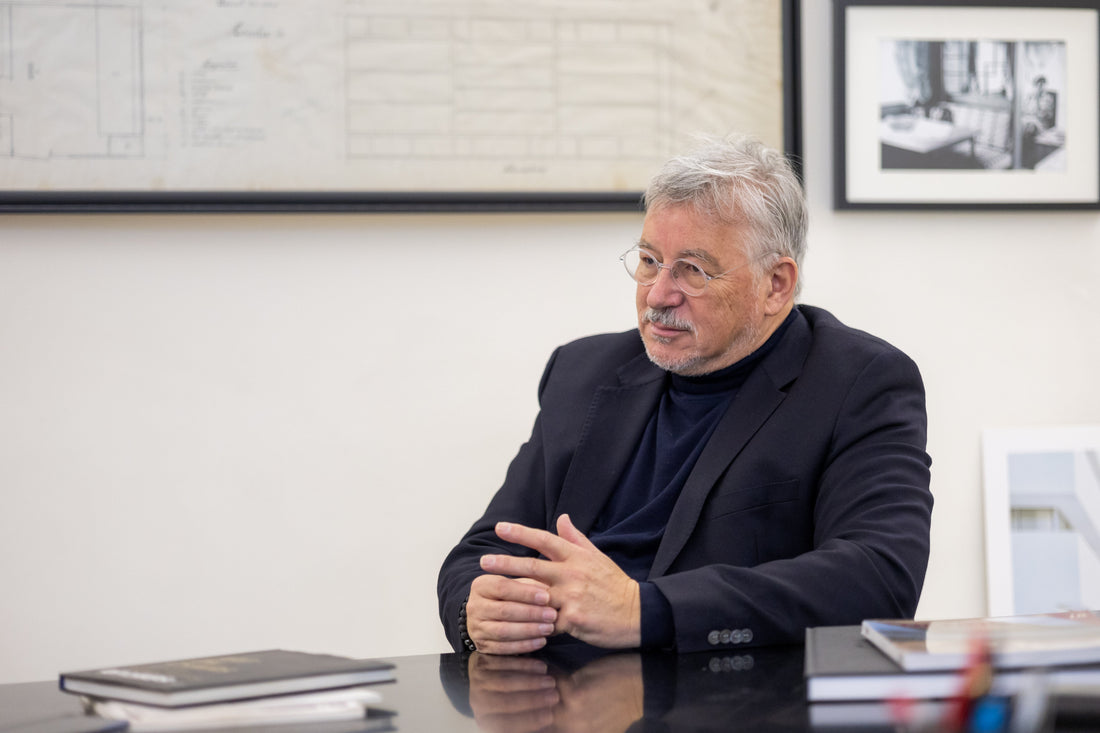
JORGE TEIXEIRA - Architect and CEO of ADA-Architecture Studio
Share
«The capacity for symbolic interpretation inspires me»
The motorhomes his father designed and built were a source of inspiration during his childhood, but the credit for designing and thinking well belongs to him. Jorge Teixeira, an architect for over three decades and founder of ADA-Atelier de Arquitetura, has built unique projects nationally and internationally and has many stories to tell. A pioneer of the Passivhaus method in Portugal, environmental awareness remains a major concern in his professional practice.

How did your taste for architecture come about?
It appears around the age of 11 or 12. My parents had left Lousado for Porto, and I studied at the Gomes Teixeira School, where I was fortunate to have a drawing teacher, also an architect, and I became one of the best students in my class. I was fortunate to draw well, and on Saturdays, he was kind enough to invite us to model airplanes. When the planes were ready, we would launch them at Francisco Sá Carneiro Airport. When I went to his studio and began to understand what architecture was, that was a defining moment for me. I already had an artistic calling, without a doubt, but I owe much of my definition of the role of an architect to Mesquita. I took the six-year course, and it was a course I completely fell in love with. I had the privilege of having architect Siza Vieira as my year manager and later architect Eduardo Souto Moura as my professor. I still have sketches of their analyses of our work, which I keep religiously.
And the creation of the ADA? Was it a will?
The acronym ADA came about because I wanted to be at the top of the Yellow Pages. At the time, the market was very tough, and my name began with a J, so it was the way I found to position myself. I always wanted to pursue my work and leave Portugal professionally; I had this need to create my own space. Back then, it was difficult to impose a design and avoid regressing 30 years compared to the big cities. The first clients who knocked on my door wanted a traditional house, with granite pillars and tiled roofs, and I turned down several jobs. But I managed to bring my identity to people. I had the opportunity to design an iconic building in Trofa, a curved glass building, which was my first office. Years later, in China, I designed three shopping malls, winning an award from China Retail. And there were countless international projects along the way, including a Vodafone headquarters in Mozambique.
How do you see architecture in Portugal and the perspective that we, Portuguese, have on architects?
I believe the perspective has changed a lot. I think the country has made a huge cultural leap. The Portuguese are very funny, they resist a lot, but when they let themselves be won over, they fall madly in love. I'll give you an example: even today in Europe, if we travel to Spain or France, the typology and design of homes remain traditional. Today, in Portugal, no one wants a house with that kind of design anymore. When I started my professional career, I experienced exactly the opposite: I faced this resistance. But this is viral, because the Portuguese, from the moment they realized that wealthy people started building modern homes, wanted them too. And this led to people being able to notice the huge differences. Being in a living room with a large glass window in front, having the outdoors in, being able to witness a storm or a sunset, is something that allows for relaxation in a very busy life. And that can't be exchanged for anything else. It's clear that aesthetic and conceptual understanding is something deeper, and that our high schools have given up on fostering it in people. No one can love what they don't know. But when we explain the conceptual idea to people, they understand.
When it comes to urban planning and public investment, do you think Portugal has evolved in the way it manages bureaucracy, planning, and opportunities?
We are a creative country; it's no coincidence that we have two Pritzker Prize winners. Today, we have the most expensive and extensive infrastructure per capita in Europe. Not even Germany has the infrastructure costs we have per capita. This is one of the major planning problems in our territory, and it's reflected in our management. Municipal Master Plans, for example, are essential, but many local authorities woke up to them too late. Some are still very confusing, unclear, and lacking strategic meaning. The actual survey was very inaccurate; we could have done much better.
Is environmentally friendly construction a concern when you think about a project?
Yes, this concern began when I was finishing my degree, when I participated in a seminar in Quebec. Canada was the first country to show this environmental awareness. In the 1980s and 1990s, it developed a program to make buildings more efficient and create legislation that would allow for better thermal insulation. Later, Germany also began to develop this theme, through Professor Wolfgang Feist, who at that time realized he could build a different kind of house. He was a physicist and created the Passivhaus certification. When I heard about Passivhaus, I knew this was what I wanted. Because I clearly understood that our climate has very wet and very cold winters, and for decades, construction was done without concern for thermal insulation. I was one of the first architects to focus on this, and later on, on Passivhaus. I trained in this methodology in Portugal and managed to build some Passivhaus houses. The truth is, today my clients are thrilled to have a home with this environmental quality. One of the advantages of Passivhaus is that air filtration is renewed 60% per hour, and the temperature is completely stabilized throughout the day, week, and year. This allows for energy savings of 60-70%. Today, we already have many Passivhaus homes across the country. Last year, I completed a Master's degree in Barcelona on circular construction and the circular economy. I must be the only person in this country with a Master's degree in this field and with very specific knowledge of the challenges facing construction in the coming years.
Are you feeling a search for a new lifestyle in your customers' requests? Specifically, a desire for closer ties with nature, a more minimalist design, comfort combined with details...
Especially after the pandemic, the paradigm of the people who came to my studio completely changed. They no longer wanted a big house; they wanted a simple, comfortable one. Portugal has a need to buy a house, to invest all their work effort in housing. And in this sense, when people buy houses today, they seek a more sustainable home with faster construction. Furthermore, they don't want to be alone in nature; they want to be with nature. There's a very strong awareness of the need to be in tune with nature, especially among the younger generations, who are brilliant in this regard. They want to live, to experience, and they're not attached to material goods.
What type of project do you enjoy most? Is there one in particular you'd like to highlight?
It's a complicated question to answer, because for those who have designed hospitals, which are perhaps the most complex building, or a level 3 laboratory... But a house, a small house, can be a delightful project and a great challenge for an architect. Because the house encompasses everything. The house is a laboratory in the kitchen, a hospital in the bathroom, a social and institutional space in the living room, a family space at the table, and an intimate space in each bedroom. If it's well thought out and designed with each family in mind, it's a great challenge.
Where do you look for inspiration? Do you have any architectural references?
I'm inspired by the capacity for symbolic interpretation. I've been following questions of philosophy and symbolism for many years. Sculpture has carried a symbolic charge since ancient times; it's ancestral, as is the case with Celtic sculpture. And this ability to understand what I'm seeing led me to seek the symbolic side. And the symbolic side led me to realize that I can't create without having a symbolic structure within me. For me, each object is an exploratory object and a moment of learning. We project our persona into what we create. My current moment is a fractal moment. I believe that the detail is the co-substantiation of the whole.
Besides architecture and sculpture, how do you spend your free time?
I enjoy spending time with my family. I focus on issues that provide me with knowledge for my professional practice. I dedicate myself to philosophy, history, experimental archaeology, and questions of ancestry. I'm in the process of forming a Celtic association.
Do you have many projects and dreams to fulfill?
Professionally, I want to develop a wave lake for surfing; it's a project we have for the country, already underway in the Algarve. But my biggest project right now is to raise the level of people's experience in nature tourism, but in a preserved nature. To bring people a new awareness of the environment and the world we live in. That's my biggest concern.

Text: Carla Martins
Photos: Ana Nogueira
